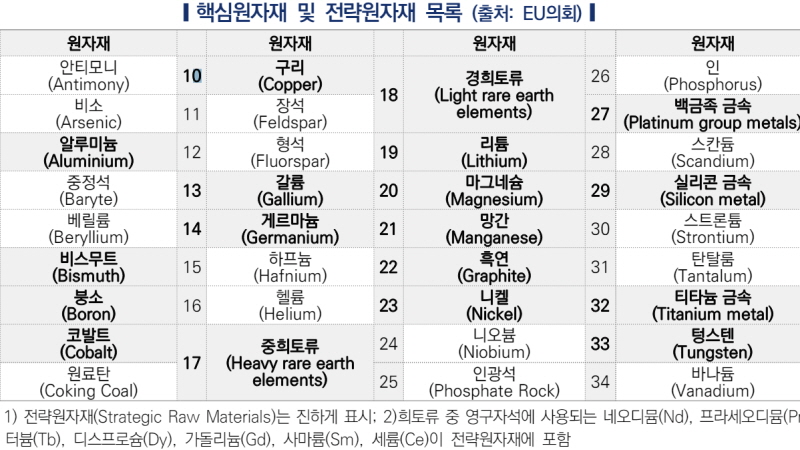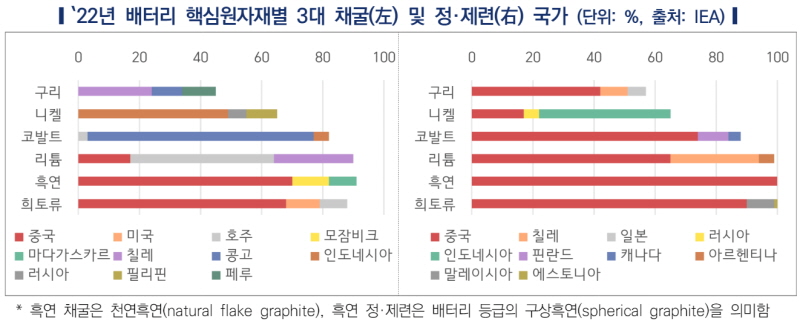지난 3월 최종 승인된 유럽의 핵심원자재법(Critical Raw Materials Act, 이하, CRMA)은 역외산 제품에 대한 차별 조항을 명시하고 있지는 않으나, 간접적 영향이 예상되는 산업 및 기업은 공급망 다변화 및 원자재 정보 수집·관리 등을 위한 장기계획 마련 필요하다는 한국자동차연구원(이하 한자연)의 보고서가 발간됐다.
배터리·전기차 산업 원자재 가공 및 정·제련 중국 의존도 높아…공급망 다변화 검토 必
역외산 제품 차별 조항 명시 없어…향후 구체적 이행계획 따라 실질적 규제 가능성 존재
지난 3월 최종 승인된 유럽의 핵심원자재법(Critical Raw Materials Act, 이하, CRMA)은 역외산 제품에 대한 차별 조항을 명시하고 있지는 않으나, 간접적 영향이 예상되는 산업 및 기업은 공급망 다변화 및 원자재 정보 수집·관리 등을 위한 장기계획 마련 필요하다는 한국자동차연구원(이하 한자연)의 보고서가 발간됐다.
임현진 한자연 산업분석실 선임연구원은 ‘EU CRMA의 주요내용 및 대응방향’을 주제로 한 산업분석 Vol.134에서 배터리 및 전기차 산업은 전략원자재 조달 측면에서 중국에 대한 의존도가 높아 공급망 다변화, 원자재 정보 수집 및 관리의 필요성을 인식하고 사전에 대비해야 하며 EU 배터리법(Battery Regulation) 등 다른 법안과 연계하여 CRMA의 영향 점검이 필요하다고 전했다.
지난 3월 유럽 이사회는 핵심원자재의 공급망 강화 및 제3국 의존도를 낮추는 것을 골자로 한 CRMA를 최종 승인했다.
지난 3월 유럽 이사회에 의해 최종 승인된 CRMA는 특정 국가에 대한 의존도 완화 및 역내 공급망 강화를 목적으로 하며, 이러한 목적 달성을 위한 전략원자재 관련 세부 목표 및 전략을 제시하고 있다.
EU는 공급망 강화의 목표 및 대상 원자재를 선정하기 위해 핵심원자재(Critical Raw Materials) 및 전략원자재(Strategic Raw Materials) 개념을 도입했다.
총 34개의 핵심원자재 중 17개의 원자재가 전략원자재로 선정되었으며, 전기차 배터리 및 연료전지 제조에 사용되는 리튬, 코발트, 니켈, 흑연 등이 전략원자재에 포함되었다.

▲핵심원자재 및 전략원자재 목록(그림 출처: 한국자동차연구원 산업분석 Vol.134)
EU는 2011년부터 경제적 중요도 및 공급 리스크가 높은 핵심원자재를 3년마다 지정하여 공급망 리스크를 분석해왔으며, CRMA를 통해 전략적 중요성, 미래 수요 증가 가능성, 생산량 확대 어려움 등이 큰 전략원자재의 개념을 추가로 도입했다.
CRMA의 주요 목적은 선정된 원자재에 대해 지속가능한 공급망을 구축하고 특정 국가에 대한 의존도를 낮춰 EU의 경제적 전략 자율성을 보호하기 위함이다.
임현진 선임연구원은 CRMA는 전기차용 배터리 및 부품 제조 기업에 영향을 미칠 수 있으므로, 공급망 다변화, 영구자석 및 제품에 사용된 원자재에 대한 정보 수집·관리 등을 위한 장기계획 마련이 필요하다고 강조했다.
CRMA는 역외산 제품 등에 대한 차별 조항은 명시하고 있지 않으며 전략원자재에 대한 EU의 전체소비량을 기준으로 목표를 제시하고 있어, 개별 기업 및 제품에 대한 직접적인 영향은 제한적일 것으로 예상된다.
그러나 향후 법안에 근거한 구체적인 이행계획 및 정책이 수립됨에 따라 실질적인 규제가 이루어질 가능성도 배제할 수는 없다.
예를 들어 CRMA는 각 회원국이 법안 발효일로부터 2년 이내에 원자재 재활용 관련 기술진보, 핵심원자재의 재사용 장려 등을 위한 인센티브 프로그램을 시행하도록 규정하고 있어 관련 정책 동향을 모니터링해야 한다.
특히 배터리 및 전기차산업에 사용되는 원자재의 가공 및 정·제련공정은 중국에 대한 의존도가 높아 CRMA에 근거한 세부 제도 및 프로그램 설계시에 주요 정책대상이 될 가능성 존재하므로 관련 품목의 가치사슬별 투입되는 원자재의 수입 지역 등을 사전에 점검해야 한다.

▲2022년 배터리 핵심원자재별 3대 채굴 및 정·제련 국가(그림 출처: 한국자동차연구원 산업분석 Vol.134)
EU 배터리법(Battery Regulation) 등 다른 법안과 연계하여 CRMA의 영향 점검도 마찬가지다.
CRMA는 최소 25%의 역내 재활용 역량 보유 목표만을 제시하고 있으며, 2027년 1월까지 전략원자재 재활용이 필요한 폐기물 목록 및 각 폐기물별로 재활용되는 전략원자재 비중을 구체적으로 명시해야 한다.
지난 2월부터 배터리 원자재의 재활용 최소 비율을 규정한 EU 배터리법(Battery Regulation)과 연계하여 전략원자재의 역내 재활용 목표를 예측하고, 관련 제품 기업 등은 역내 재활용 원자재 확보 준비가 필요하다.
EU 배터리법의 재활용 최소 비율은 2031년부터 코발트 16%, 리튬 6%, 니켈 6%의 비율이 적용되며, 2036년 기준이 상향될 예정이다.
또한 배터리법에서 전기차 배터리가 탄소발자국의 측정·신고의 의무대상으로 지정되었으므로, 향후 전기차용 배터리 및 부품에 CRMA의 환경발자국 평가 및 정보제공 의무를 부과할 가능성이 높다.
환경발자국, 영구자석 등과 관련된 정보공개 및 규제 등은 최소 3년 후 발효 예정이므로, 이행 및 위임규정 입법 동향을 꾸준히 모니터링하여 재생원료 공급망 확보 등 장기적인 전략 수립을 해야 할 것으로 보인다.
한편 CRMA는 특정 국가에 대한 의존도 완화 및 역내 공급망 강화 목적 측면에서 미국의 IRA와 유사하나, 역내 제품에 대한 우대조치, 제3국의 제품 및 개별 기업에 대한 불이익 등을 명시하지는 않았다는 점에서는 차별성을 가진다.
CRMA는 △탄력적 공급망 구축 △공급망 리스크 모니터링 및 관리 △원자재 순환성 및 지속가능성 강화 등의 목적 달성을 위해 구체적 목표 설정 및 기반 마련을 위한 전략을 제시하고 있다.
2030년까지 EU 전략원자재 연간소비량의 △최소 10%를 역내에서 채굴 △최소 40%를 역내에서 가공 △최소 25%를 역내 재활용을 통해 생산할 수 있는 역량을 마련하고 재활용 비율을 확대 △특정 역외국가로부터의 수입량이 EU 연간소비량의 65%를 초과하지 않도록 목표를 설정 등이 주 내용이다.
이 중 재활용 관련 목표는 지난해 3월 CRMA 초안에서 제시되었던 15%보다 비교적 큰 폭으로 상향 합의되었다.

